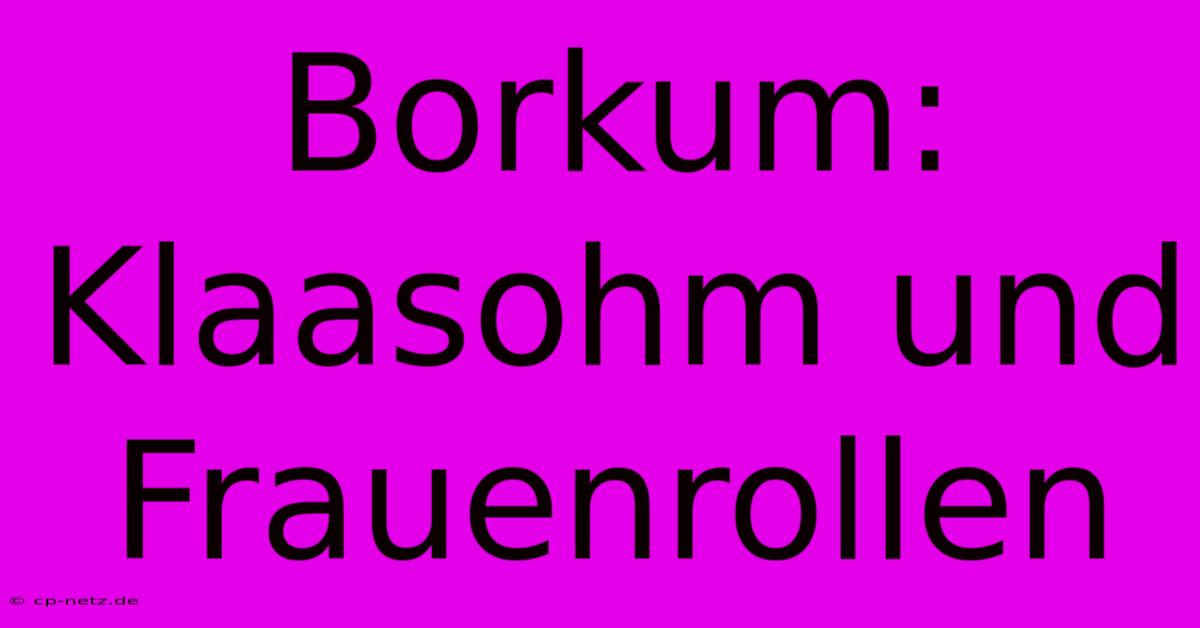Borkum: Klaasohm Und Frauenrollen

Discover more detailed and exciting information on our website. Click the link below to start your adventure: Visit Best Website Borkum: Klaasohm Und Frauenrollen. Don't miss out!
Table of Contents
Borkum: Klaasohm und Frauenrollen – Ein Blick auf die Inselgeschichte
Hey Leute! Let's talk about Borkum, specifically the fascinating interplay between the Klaasohm (the traditional fishing community) and the roles of women on the island. This isn't just some dusty history lesson; it's a really cool look at how a unique community shaped its gender dynamics. And trust me, it's way more interesting than it sounds!
I'll be honest, when I first started researching Borkum's history, I kinda glossed over the women's roles. I was, like, "Fishing? That's a dude thing, right?" Face palm. Boy, was I wrong. This whole thing really opened my eyes.
The Klaasohm: More Than Just Fishing
The Klaasohm – that's the heart of traditional Borkum life. It's not just about catching fish; it's a whole way of life, deeply intertwined with the island's identity. These weren't your average fishermen; they were intensely connected to the sea, their boats, and their families. They relied on a complex network of knowledge, skill, and cooperation – and guess what? Women were integral to that network.
My initial mistake was focusing solely on the physical aspects of fishing – hauling nets, mending sails. I thought, "Obviously, women wouldn't be doing that heavy labor." But I missed the bigger picture. The wives and daughters of the Klaasohm weren't just sitting at home knitting.
Beyond the Nets: The Unsung Heroines of Borkum
Think about it: While the men were out at sea, often for days, someone had to keep the home fires burning, literally and figuratively. The women were responsible for managing the household, looking after children, preparing meals, and—crucially—handling the finances. They often ran the businesses connected to the fishing industry, selling the catch, negotiating prices, and ensuring the family’s economic stability. This wasn't a passive role; they were the economic backbone of many Klaasohm families.
I found some amazing old photos during my research – they showed women fiercely bargaining in the market, their faces etched with determination. It was a total revelation! These weren't meek, subservient figures; they were powerful women who played a vital role in the Klaasohm's success. Seriously, it made me rethink a lot of my assumptions about gender roles in historical contexts.
The Sea's Influence on Gender Roles
The harsh realities of island life also played a big part. The sea is unpredictable; life was precarious. This environment fostered a strong sense of community and mutual reliance – men and women needed each other to survive. That interdependence didn't necessarily translate into perfect gender equality, but it did create a dynamic where women's contributions were essential and highly valued.
One anecdote I came across involved a woman who took over her husband’s fishing business after his death, successfully navigating the challenges of the Klaasohm and ensuring her family's future. That kind of resilience, that kind of strength, truly embodies the spirit of Borkum women.
Lessons Learned & Further Exploration
My initial naive view of Borkum’s Klaasohm completely underestimated the influence of women. Learning about their significant role highlighted the importance of detailed historical research and challenging preconceived notions. This isn't just about Borkum; it applies to countless historical communities.
I encourage you to delve deeper. Search for historical records, explore local museums, and maybe even visit Borkum itself – the island’s beauty is complemented by its rich and fascinating history. Let's move past stereotypical gender roles and explore how communities truly functioned, appreciating the contributions of all its members. It's a more rewarding way to understand history, trust me.

Thank you for visiting our website wich cover about Borkum: Klaasohm Und Frauenrollen. We hope the information provided has been useful to you. Feel free to contact us if you have any questions or need further assistance. See you next time and dont miss to bookmark.
Featured Posts
-
Magdeburg Hertha Bsc Auswaertssieg
Nov 30, 2024
-
Hertha Rueckrunden Dauerkarte Jetzt Bestellen
Nov 30, 2024
-
Klaasohm Maskierte Greifen Frauen Auf Borkum An
Nov 30, 2024
-
Junges Giraffenkalb In Schoenbrunn Tot
Nov 30, 2024
-
Schalke Besiegt Fck Klettert Auf Platz 2
Nov 30, 2024
